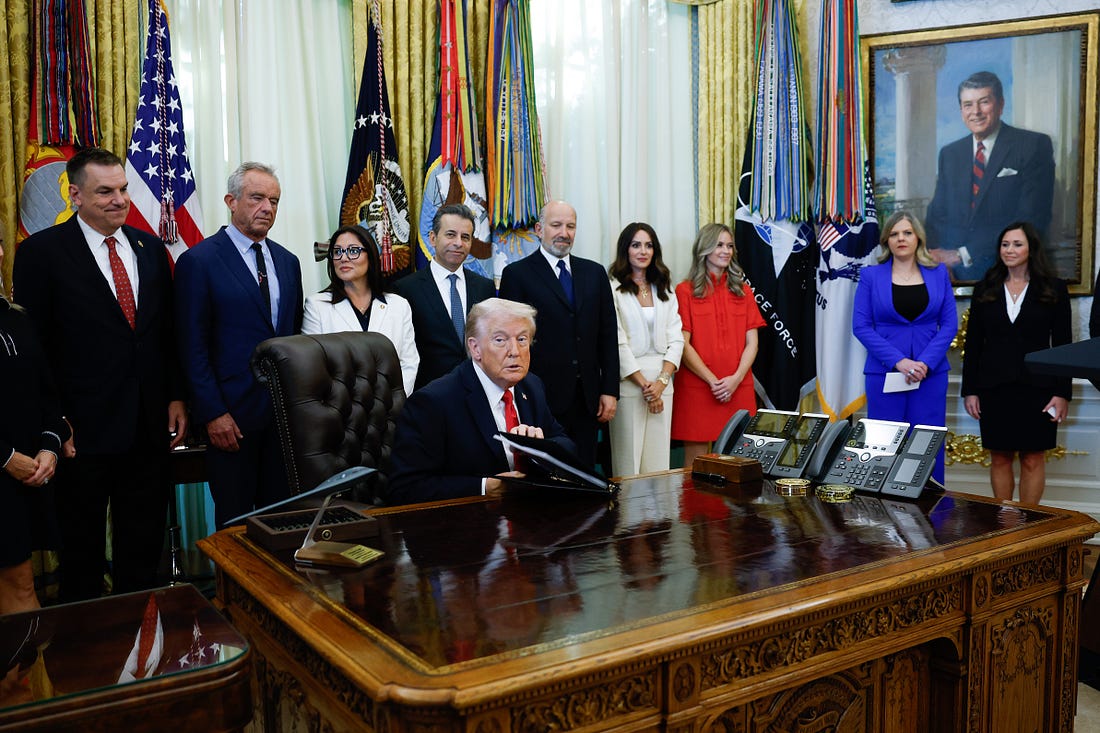|
 |
DONALD TRUMP MADE A BIG, SPLASHY ANNOUNCEMENT at the White House on October 16, when he revealed that a key fertility drug manufacturer had agreed to lower some of its prices.
There are two important things to know about this development.
The first is that the agreement really could help some people. Knocking down the price even incrementally would be no small thing for people scraping together the money to pay for a process that health insurance frequently does not cover at all.
The second is that the agreement falls way short of making IVF free, which is what Trump had promised as a candidate. A single course of IVF—which isn’t guaranteed to work—can cost anywhere from $10,000 to $30,000, with drugs typically accounting for less than a quarter of that total. The rest comes from expenses like physician services and lab fees that the agreement on drug prices won’t touch.¹
It’s not even clear how many people will really save from the pledged drug-price reduction. Trump administration officials boasted that EMD Serono, the Merck subsidiary lowering the price of the fertility medication, would start selling its drugs by as much as 84 percent less than the list price. But drug list prices are a bit like sticker prices on the car dealer lot, with the manufacturers negotiating reductions with insurers (or pharmaceutical middlemen) and frequently offering direct discounts to people without coverage, based on need.
All of those negotiations are confidential, including the prices, and the Trump administration—as it is wont to do—has released few additional details.
“For some people who are on the margin of being able to pay for treatment, this extra lower cost could make a difference,” Stanford University economist Maria Polyakova, who has studied fertility treatment pricing and access, told me. “But then for people who are really priced out of this procedure, I don’t think this is going to be enough.”
Presidents fail to deliver on campaign promises all the time, of course. But the free IVF pledge had served an especially important function for Trump while on the trail.
It was his way of reassuring supporters anxious about access to fertility treatments following a 2024 Alabama court ruling that IVF’s destruction of unused embryos—those created for IVF procedures but not implanted, and left frozen in IVF clinics—violates that state’s abortion ban. The October 16 announcement makes clear that Trump has backed off the free IVF pledge—at least in part, as the Washington Post has reported, because of objections from anti-abortion groups.
That position is not universal among conservatives. The Catholics who have been a major force in the anti-abortion movement oppose IVF on moral and theological grounds. But the evangelical Protestants who form an important MAGA bloc generally support IVF.
If Trump were serious about living up to his campaign promises, he could find a way to put together a coalition for passing legislation that would truly make IVF available to all—or, at least, to many more people than it is now. But that would require him to engage with a policy issue at more than a superficial level—and to patiently manage the legislative process rather than lunge for easy PR spectacles promising lots of “Trump babies.”
In other words, it would require Trump to be the sort of president he has never been.
TRUMP OBVIOUSLY DOESN’T think about policy in the way his predecessors have. He governs on instinct, with a heavy emphasis on self-aggrandizement and self-preservation plus an undisguised disdain for detail. But every once in a while Trump’s instincts take him to interesting, unexpected places.
If you go back and listen to or read Trump from twenty or thirty years ago, you’ll find him talking up Canada’s national health care system—“If you can’t take care of your sick in the country, forget it,” he said in a 1999 interview—and expressing pique that Americans were paying so much for prescription drugs while the citizens of other countries were paying so much less.²
By the time Trump was running for president, he cared more about trying to undo Barack Obama’s signature legacy (the Affordable Care Act) than making health care a universal right. But he kept decrying the high drug prices in the United States, just as he kept pointing out that Germans, Swedes, Brits, and others were getting a better deal than Americans. That’s not surprising, given how neatly this problem lines up with his belief that other countries are taking advantage of the United States, or at least getting deals Americans aren’t.
